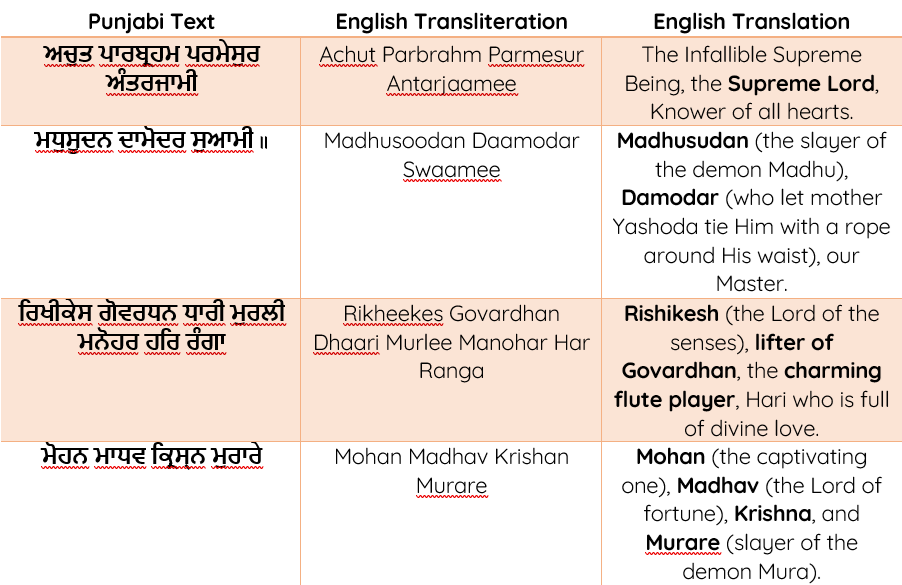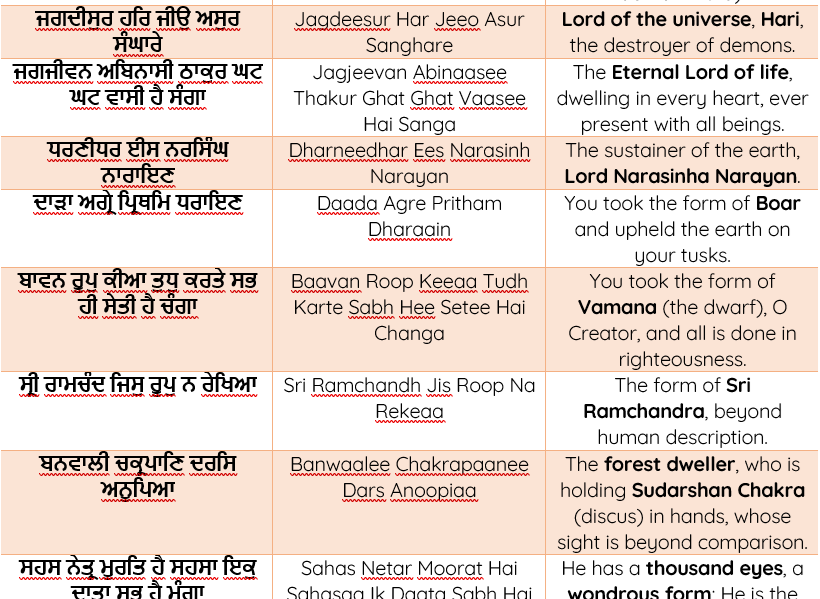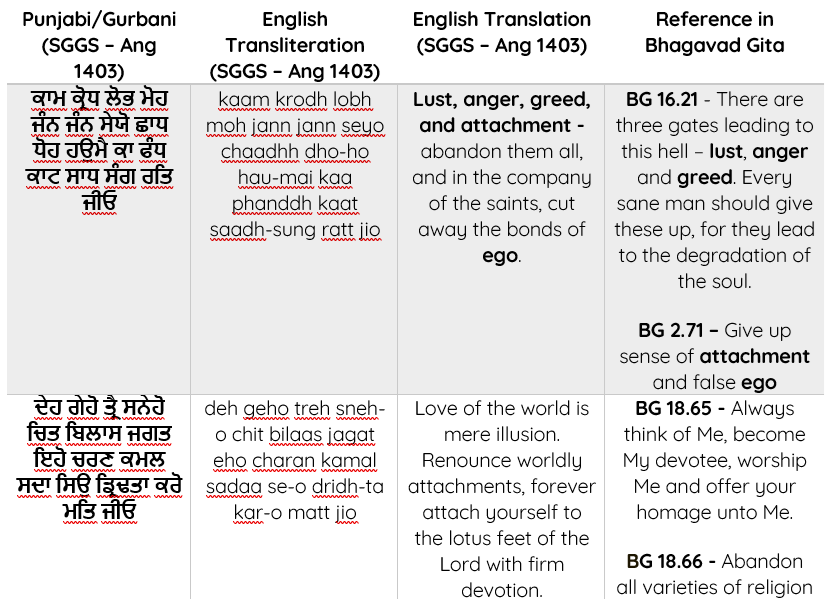Bhagavad Gita vs. Sri Guru Granth Sahib: A Journey to the Same Absolute Truth

Religious scriptures have long been a guiding light for humanity, helping us understand the purpose of life and our relationship with the Divine. In a world often divided by differences in belief, culture, and ideology, the search for universal truths remains a common thread that unites humanity.
While there are diverse religious paths, it is fascinating to explore how they ultimately lead to the same Absolute Truth. Two such scriptures are the Bhagavad Gita (BG) from Hinduism and Sri Guru Granth Sahib (SGGS) of Sikhism. Though these texts emerge from different traditions, a closer look reveals the striking parallels in their spiritual teachings.
This article presents a comparative study to highlight these similarities, focusing on three key aspects:
- The Mool Mantra (the opening text of Sri Guru Granth Sahib) and its reflections in the Bhagavad Gita
- The universal message of Ardas (Sikh prayer) and its alignment with the Bhagavad Gita’s call for the welfare of all beings
- The representation of Lord Krishna in Sri Guru Granth Sahib through divine names like Govind, Madhav, Murari, and their link to the Gita’s depiction of the Supreme Personality of Godhead.
The article concludes by illustrating how both the Bhagavad Gita and Sri Guru Granth Sahib emphasize on renunciation of negative traits, such as Lust, Anger, Greed, Attachment & False Ego, and the importance of surrendering to the Divine.
Introduction
* The Bhagavad Gita – This700-verse ancient scripture is the essence of Vedic knowledge and one of the most important Upanisads in Vedic literature. Lord Sri Krsna spoke it 5000 years ago to the prince Arjuna on the Battlefield of Kuruksetra. As the essence of the 108 Upanisads, it is sometimes referred to as Gitopanisad.
The Bhagavad Gita’s teachings are timeless and universal, and provide us with a blueprint for living – one that helps us navigate the complexities of modern life with purpose, balance, and inner peace. It’s widely regarded as one of the greatest self-help and philosophical texts ever written.
* TheSri Guru Granth Sahib – This is a sacred scripture of Sikhism and is a collection of compositions from various contributors, primarily the Sikh Gurus, but also includes writings from other spiritual figures. It has 1430 Angs (Pages).
It was first compiled in 1604 by the fifth Sikh Guru, Sri Guru Arjan Dev Ji. Later, in 1705, the tenth Sikh Guru, Sri Guru Gobind Singh Ji, finalized the text by adding the hymns of the ninth Sikh Guru, Sri Guru Tegh Bahadur Ji, and declared that the Sri Guru Granth Sahib would serve as the eternal Guru & spiritual guide for Sikhs, thereby ending the line of human Gurus.
1. Mool Mantra: The Essence of Sikhism
The Mool Mantra is the opening text of Sri Guru Granth Sahib. It is said to be the first composition uttered by Sri Guru Nanak Dev Ji – founder of Sikhism (1469-1538) upon enlightenment at the age of about 30.
It serves as a foundational understanding of God and reality, with every phrase echoing a profound truth found in the Bhagavad Gita. Below is the comparison of the key phrases of the Mool Mantra with corresponding verses from the Bhagavad Gita, highlighting the shared spiritual insights.
| Mool Mantra from SGGS | Meaning | Reference in Bhagavad Gita |
|---|---|---|
| Ik Onkar | One Universal Creator God | BG 10.3: “I am the Supreme Lord of all the worlds.” |
| Satnam | The Name Is Truth | BG 7.7: “There is no truth superior to Me.” |
| Karta Purakh | Creative Being Personified | BG 7.10: “I am the original seed of all existences.” |
| BG 9.17: “I am the father of this universe, the mother.” | ||
| BG 11.37: “You are the original creator.” | ||
| Nirbhau | No Fear | BG 7.11: “I am the strength of the strong.” |
| BG 10.4: “Fear, fearlessness—all these are created by Me alone.” | ||
| Nirvair | No Hatred | BG 10.29: “I envy no one, nor am I partial to anyone. I am equal to all.” |
| Akaal Murat | Image Of The Undying | BG 7.21: “I am in everyone’s heart as the Supersoul.” |
| Ajooni | Beyond Birth | BG 4.6: “I am unborn.” |
| BG 10.3: “I am the beginningless, the unborn.” | ||
| Saibhang | Self-Existent | BG 8.9: “He is luminous like the sun.” |
| BG 11.12: “Their radiance might resemble the effulgence of the Supreme Person.” | ||
| Gur Parsaad | By Guru’s Grace | BG 4.24: “Learn the truth by approaching a spiritual master.” |
| Jap | Chant And Meditate | BG 18.65: “Always think of Me, become My devotee.” |
| Aad Sach, Jugaad Sach, Hai Bhi Sach, Nanak Hosi Bhi Sach | True In The Primal Beginning. True Throughout The Ages. True Here And Now. O Nanak! Forever And Ever True. | BG 7.26: “I know everything that has happened in the past, all that is happening in the present, and all things yet to come.” |
The Mool Mantra not only emphasizes the existence of one Supreme God but also resonates deeply with the core teachings of the Bhagavad Gita. Both scriptures reinforce the belief that the Divine is Eternal, Omnipresent, and the Ultimate Creator.
2. End of Ardas (Prayer) – A Reflection of Bhagavad Gita 5.25
At the conclusion of the Sikh daily prayer, known as Ardas, a beautiful phrase is recited: “Nanak Naam Chardi Kala Tere Bhane Sarbat da Bhala.” This translates to a prayer for universal well-being. Each word holds deep meaning:

This is remarkably similar to the teachings in Bhagavad Gita 5.25, where Lord Krishna speaks of the welfare of everyone (सर्वभूतहिते रता: Sarva Bhuta Hite Rata). Both these scriptures emphasize selfless service, compassion, and the upliftment of all living beings.
3. Divine Forms and Names of Lord in the Sri Guru Granth Sahib
Interestingly, the Sri Guru Granth Sahib contains over 8000 references to the word “Har / Hari”– a name for God, and other divine names like Krishna, Govind, Murari, Madhav, Gopal, Damodar and Rama. This reflects the deep reverence for various forms of God, and glorifies Lord Krishna in multiple forms. Below are only few of many such beautiful excerpts from Sri Guru Granth Sahib
i. Sri Guru Granth Sahib, Ang / Page 567 (composed by Sri Guru Nanak Dev Ji – 1st Sikh Guru) : Sri Guru Nanak Dev Ji’s deep love for Krishna
A beautiful composition by Sri Guru Nanak Dev Ji, the founder of Sikhism, which highlights his admiration for the beauty and divine qualities of Krishna, as expressed in poetic and spiritual terms.

ii. Sri Guru Granth Sahib, Ang/Page 1082 (composed by Sri Guru Arjan Dev Ji – 5th Sikh Guru) : Echoes of Vishnu Sahasranama
The following table shows a beautiful composition by Sri Guru Arjan Dev Ji that echoes the Vishnu Sahasranama literature from the Hinduism, further illustrating the shared reverence for Lord Krishna.
This passage emphasizes how Sikh Gurus held deep love for Krishna, acknowledging his various avatars and divine deeds.


iii. Sri Guru Granth Sahib, Ang/Page 1008 (composed by Sri Guru Teg Bahadur Ji – 9th Sikh Guru) – Har Ko Naam Sada Sukhdai
This verse from the Sri Guru Granth Sahib speaks of the power of Hari name and His grace in saving his puree devotees and liberating even the most sinful and distressed souls.

4. Key Practical Teachings & Surrendering to God
Both Sri Guru Granth Sahib and the Bhagavad Gita, emphasize upon the importance of letting go of destructive emotions such as lust, anger, greed, attachment, and ego, and surrendering to the Divine. Key teachings from Sri Guru Granth Sahib, Ang/Page 1403, and corresponding verses in Bhagavad Gita –

Conclusion
In conclusion, despite the 4500-year gap between the Bhagavad Gita and the Sri Guru Granth Sahib, it becomes evident that Sikhism’s core teachings are deeply rooted in the spiritual framework of Sanatana Dharma.
Although the Bhagavad Gita and the Sri Guru Granth Sahib come from distinct cultural and historical backgrounds, they share profound similarities in their spiritual essence. Both scriptures affirm that the Divine is eternal, unborn, omnipresent, infallible, self-sufficient, and the ultimate creator. Both advocate for letting go of lust, anger, greed, attachment, and ego, while emphasizing the importance of devotion and remembrance. Furthermore, both texts emphasize compassion and the welfare of all beings, calling for selfless service and universal well-being.
Thus, the teachings of Sikhism, as expressed through the Sri Guru Granth Sahib, can be seen as a continuation and a modern expression of the timeless principles found in the Bhagavad Gita and Sanatana Dharma, guiding humanity toward the ultimate goal of self-realization & unity with the Supreme Truth.
References
- Bhagavad-gītā As It Is by A. C. Bhaktivedanta Swami Prabhupada, 1st ed., Bhaktivedanta Book Trust, 1968.
- Sri Guru Granth Sahib (Original Sacred Text, 1705).







Fantastic analysis
Hare Krishna Prabhuji,
Thank you so much for your kind words. Being my first-ever blog, it was your motivation and encouragement only that inspired me to make this small attempt.
Your unwavering support, profound spiritual insights, and inspiring leadership have been a guiding light in my spiritual journey. I am deeply grateful for your guidance and the opportunity to learn and grow under your mentorship. Your encouragement motivates me to continue on this path of Krishna consciousness.
Thank you, Prabhuji, for everything! 🙏
Thankyou for the article Prabhujee 🙏
Really liked the point how both scriptures are meant for the welfare of humanity and thus emphasis on the same features and teachings .
Before reading Bhagavad Gita , I myself used to resonate the mool mantra and hear japji sahib which connects us to the qualities of supreme personality of godhead and his personality indirectly . Later after getting to know about the supreme personality himself through Bhagavad Gita , I could connect to the Bani of Sri Namdev ji coded in Sri Guru Granth Sahib Ji which reconciled both scriptures for me . Also later coming in association of devotees , the verses 12.2, 12.3, 12.4 of Srimad Bhagavad Gita further lighted up the way the welfare of humanity is being carried out as per both the scriptures .
Thus finding solace in the words of Supreme lord himself, who is making it so easy for all humanity through the example of Arjuna to resolve all his doubts in the most secured, practical and feasible process of being fulfilled in hearts that we are all hankering for, as explained so lucidly by Srila Prabhupada.
Thank you Mataji for taking the time to read the blog and share your thoughts. Hare Krishna 🙏
Amazing Mukesh Prabhu! Hari Bol!
Thank you so much Prabhuji for your kind words. Hare Krishna 🙏
This is amazing, Mukesh Prabhuji. Wonderful analysis to share the messages of both the divine books. Hari Bol 🙏
Thank you so much Prabhuji for taking the time to read this and sharing your encouraging feedback. Hare Krishna 🙏
Very nice blog Prabhuji. One should have made a deep study of SGGS and BG to write such an article. It’s really interesting and heart warming to know that the SGGS also has so many names of the Lord and brings out his various incarnations. This only re-affirms the fact that Krsna is the Supreme Personality of Godhead.
Wish that this message goes far and wide.
Thank you prabhuji this blog
Ys
Hare Krishna Mataji. Thank you for your encouragement and kind wishes 🙏.
Hare Krishna prabhuji. Superb article on the similarities between Sri Bhagavad Gita and the Sri Guru Granth Sahib. Very well researched and compiled.
Hare Krishna Mataji. Thank you for your kind words 🙏.
Wonderful article Mukesh Prabhu. Very nicely and thoughtfully articulated.
Through this article, I got a glimpse of what is inside The Sri Guru Granth Sahib (which was otherwise unknown to me till today) and the parallels it draws in it’s teachings with The Bhagavad Gita.
Thank you very much Prabhuji.
Hare Krishna 🙏
Hare Krishna Prabhuji. Thank you for taking time to read this. I am glad that you found it useful. 🙏.
Hare Krishna!
Dandvat Pranam!
Very nicely compiled blog Prabhuji. So much details in it, it shows how much knowledge you have of both the scriptures. My father hears Gurbani everyday and several times he discuss with me what he heard and I also share my understanding of Bhagavad Gita. We always come to the conclusion that the essence is same. If the path is right and we are sheltered either by a person Bhagavata or by the Book Bhagavata in the form of Bhagavad Gita or Shri Guru Granth Sahib, we will reach our ultimate destination.
Thank you again for such an enriching and soul gratifying piece.
Hare Krishna Prabhuji, Dandvat Pranam 🙏. I fully agree with your thoughts and the conclusion on this topic. Thank you for taking time to read this and giving your encouraging feedback🙏.